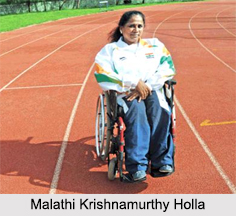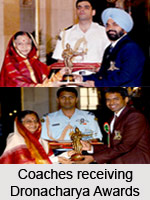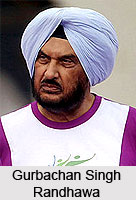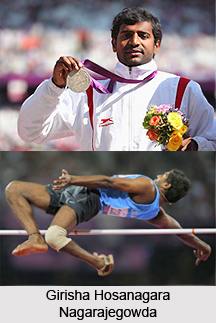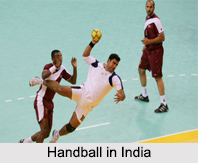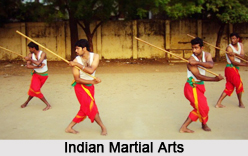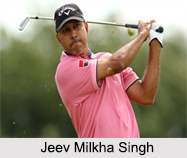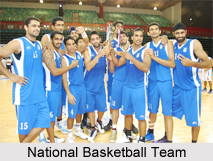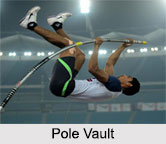 Throwing events can be divided into many types and some of them go back a long way into the pre-historic times. Some of the popular throwing events are: Spot put, Discus throwing, Javelin throw, Hammer throw. In Asian Games, Olympics and the Commonwealth Games, the throwing events now attract the spectators.
Throwing events can be divided into many types and some of them go back a long way into the pre-historic times. Some of the popular throwing events are: Spot put, Discus throwing, Javelin throw, Hammer throw. In Asian Games, Olympics and the Commonwealth Games, the throwing events now attract the spectators.
Shot Put
The origin of Shot Put dates back to pre historic competitions with rocks: during the middle ages, in Scotland, it was known as stone put and as steinstossen in Switzerland. During the 17th century the cannonball throw Game, which was played within England, provided an antecedent to modern sport. It was in the 1860 that the modern rules were first laid and the legal throws had to be taken within the square throwing area of seven feet (2.13 m) on each side.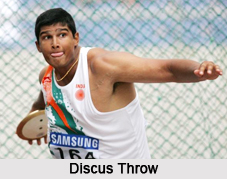 This was amended to a circle area with a diameter of 7 feet on each side. This was changed to seven feet diameter in 1906 and the weight of the shot was standardised to 16 pounds. Shot Putters are generally the largest and most explosive athletes on a team. The shot put has been an Olympic sport for men since 1896 and a women`s competition using a 4 kg (8.82 lb) shot was added in 1948. Some of the shot putters in India are Harwant Kaur, Manpreet Kaur, Deepa Malik, Parduman Singh Brar, Bahadur Singh Chouhan, Vikas Gowda, Om Prakash Karhana, Bahadur Singh Sagoo, Inderjeet Singh and Sourabh Vij.
This was amended to a circle area with a diameter of 7 feet on each side. This was changed to seven feet diameter in 1906 and the weight of the shot was standardised to 16 pounds. Shot Putters are generally the largest and most explosive athletes on a team. The shot put has been an Olympic sport for men since 1896 and a women`s competition using a 4 kg (8.82 lb) shot was added in 1948. Some of the shot putters in India are Harwant Kaur, Manpreet Kaur, Deepa Malik, Parduman Singh Brar, Bahadur Singh Chouhan, Vikas Gowda, Om Prakash Karhana, Bahadur Singh Sagoo, Inderjeet Singh and Sourabh Vij.
Discus Throw
It is one of the important events in the category of tract event, and the history of the same goes back to 708 BC. In the ancient days the game was played with heavy circular disc which was thrown from a set standing position on a small pedestal, and it was actually this style that was revived for 1896 Olympics.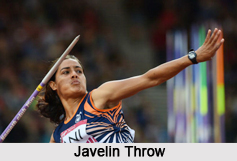 This process continued until 1906 Intercalated Games in Athens which featured both old style and increasingly popular modern style of turning and then throwing. During the 1912 Olympics the ancient standing throw style had fallen into disuse and contests starting within a 2.5 m squared throwing area became the standard. The discus implement was standardised to 2 kg in weight and 22 cm in diameter in 1907. The women`s discus was among the first women`s events on the Olympic programme, being introduced in 1928. Some of the discus Throwers in India are Seema Antil, Harwant Kaur, Tayabun Nisha, Krishna Poonia, Neelam Jaswant Singh, Akash Antil and Ranjith Kumar Jayaseelan.
This process continued until 1906 Intercalated Games in Athens which featured both old style and increasingly popular modern style of turning and then throwing. During the 1912 Olympics the ancient standing throw style had fallen into disuse and contests starting within a 2.5 m squared throwing area became the standard. The discus implement was standardised to 2 kg in weight and 22 cm in diameter in 1907. The women`s discus was among the first women`s events on the Olympic programme, being introduced in 1928. Some of the discus Throwers in India are Seema Antil, Harwant Kaur, Tayabun Nisha, Krishna Poonia, Neelam Jaswant Singh, Akash Antil and Ranjith Kumar Jayaseelan.
Javelin Throw
This form of game began in the prehistoric times as it was used as an implement of war and hunting. This game was the second throwing event in the ancient Olympic pentathlon along with discus. Records from 708 BC demonstrate two javelin competition types co-existing with each other: throwing at a target and throwing the javelin for distance. It was the latter type from which the modern event was derived. The competition of ancient times would wrap a thin leather strip around the javelin that acted as sling to gain extra distance.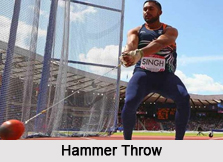 The game gained huge popularity in Scandinavia during 18th century and athletes from that region continues to dominate the sports field. The modern event features a short run up on a track and then the thrower releases the javelin before the foul line. The Olympic men javelin throw event took place in 1908 and the women version was introduced in 1932. Initially javelins were made of different types of wood, but in 1950s Bud Held, a former athlete, introduced a hollow javelin, then a metal javelin, both of which increased throwers performances. The rough-tailed javelin was introduced by another former athlete Miklos Nemeth and throws reached in excess of 100 m - edging towards the limits of stadium. Current javelin specifications are 2.6 to 2.7 m in length and 800 grams in weight for men and between 2.2 to 2.3 m and 600 g for women.
The game gained huge popularity in Scandinavia during 18th century and athletes from that region continues to dominate the sports field. The modern event features a short run up on a track and then the thrower releases the javelin before the foul line. The Olympic men javelin throw event took place in 1908 and the women version was introduced in 1932. Initially javelins were made of different types of wood, but in 1950s Bud Held, a former athlete, introduced a hollow javelin, then a metal javelin, both of which increased throwers performances. The rough-tailed javelin was introduced by another former athlete Miklos Nemeth and throws reached in excess of 100 m - edging towards the limits of stadium. Current javelin specifications are 2.6 to 2.7 m in length and 800 grams in weight for men and between 2.2 to 2.3 m and 600 g for women.
Hammer Throw
One of the earliest known precursors to modern day hammer throw stems from Tailteann Games around 1800 BC, that featured events like throwing either a weight attached to a rope, a large rock on a wooden handle, or even a chariot wheel on a wooden axle. Other ancient competitions included throwing a cast iron ball attached to a wooden handle- the main source of the term "hammer throw" due to their resemblance to the tool. During the 16th century in England there are records of contests involving the throwing of actual blacksmith Sledgehammer. The hammer implement was standardized in 1887 and the competition started to resemble modern events. The weight of the metal ball was set at 16 pounds (7.26 kg) while the attached wire had to measure between 1.175 m and 1.215 m.





